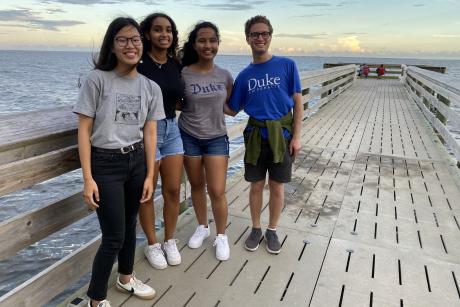
After each of our interviews, we ask the interviewee if he/she would like to pose with us in a picture. This photo was taken with a comadrona outside of her house in Concepción Huista. Photo taken by Don William Eduardo.
Published May 29, 2013, last updated on October 5, 2017 under Voices of DGHI
By Kurren Mehta
Each morning at 7 a.m., I begin my five-minute walk to breakfast. And each morning, as I weave through an endless stream of pick up trucks, baskets chock-full of ripe orange mangoes, schoolchildren in uniform, and puddles of mud, I am reminded of, and often reflect on the fact that my SRT group’s impact on the Mayan communities of Guatemala is, in a sense, limited.
That is, of course, not to say that we have failed in any way. Rather, as the first SRT group to set up shop in rural Guatemala, we play the frustrating, but often exciting role of guinea pig. While we have the principal goals of creating a compilation of herbal knowledge for the community to use as a whole, bettering our understanding of the sources of morbidity and mortality in the region, and organizing a number of dental hygiene and hand washing interventions during our stay, a significant portion of our time also goes towards establishing a long-term and sustainable site for SRT teams in the future.
We test the waters and note the strengths and weaknesses of everything from our community health partner to methods used to transcribe interviews. These evaluations are made with the hope that future SRT teams come to Guatemala with the preparedness and expectations that allow them to both build upon our fieldwork and efficiently allocate time and resources towards their own specific goals. This naturally means that the majority of the potential successes at the site will not be directly due to my group’s specific involvement, but rather indirect results of my group’s fieldwork in the region. Likewise, although direct impact is limited, indirect impact at this stage is seemingly endless.
Of course, a sufficient amount of indirect impact will almost certainly take a very long time; unfortunately, living in a world increasingly obsessed with instant gratification forces a sentiment of frustration and discontent. We have the ability to travel across the United States in a matter of hours, to make a bowl of Easy Mac in a matter of minutes, and to send an email from Jacaltenango, Guatemala to Beijing, China in a matter of seconds; yet, it is unreasonable to expect that the utmost progress when working with a community will be made due to a day, week, month, or even entire summer worth of hard work and effort.
While this, in my eyes, is easily the most frustrating thing about global health, it is also one of the most important to keep in mind. My time in Guatemala has been a continuous learning process. As convenient as it would be to wave a magic wand and have the health disparities in Maya Guatemala fix themselves, the reality of the situation is that true impact, progress, influence, and sustainability take time to achieve. Although the fieldwork we will complete over the course of this eight-week stay is critical to future success, it will by no means function as the only solution for this region. Rather, our role is a small, yet integral piece of a fairly large and complex puzzle.
Previous Blog: Beyond Observation: Holism and Overlap in Guatemala


